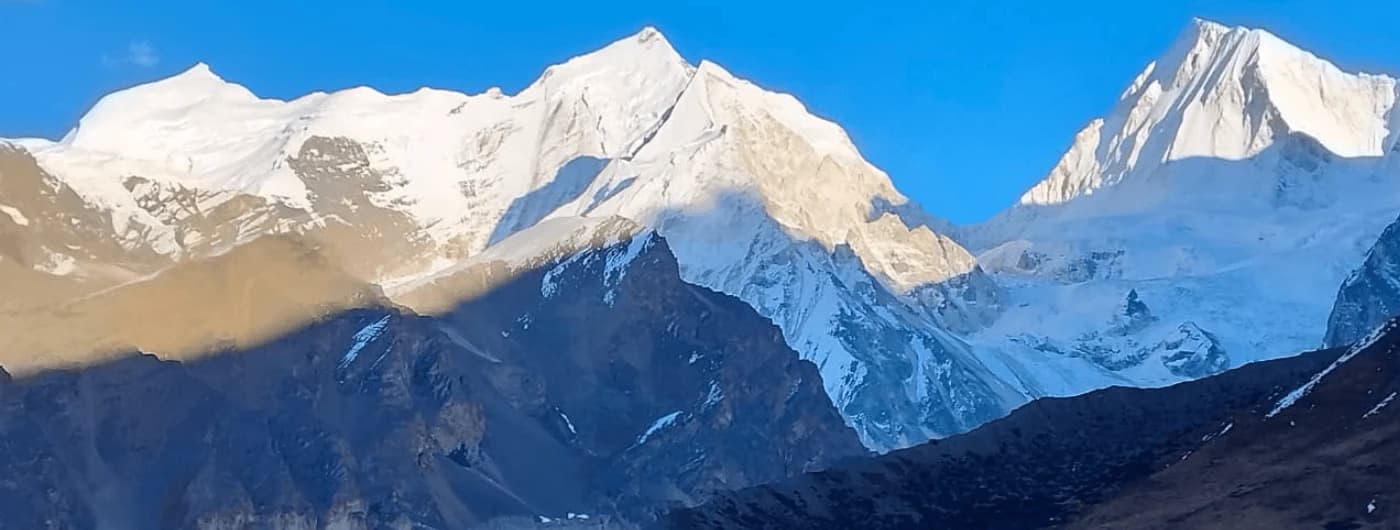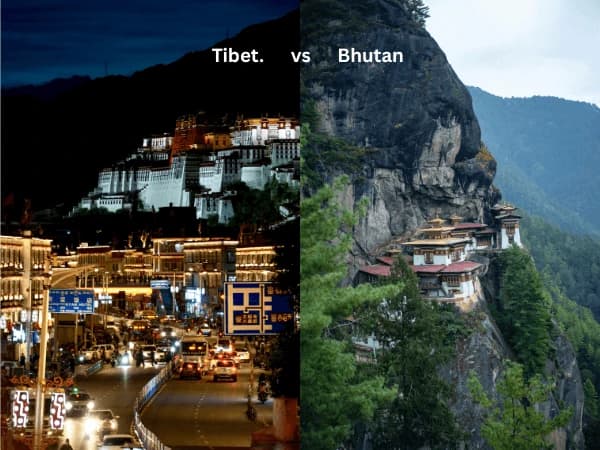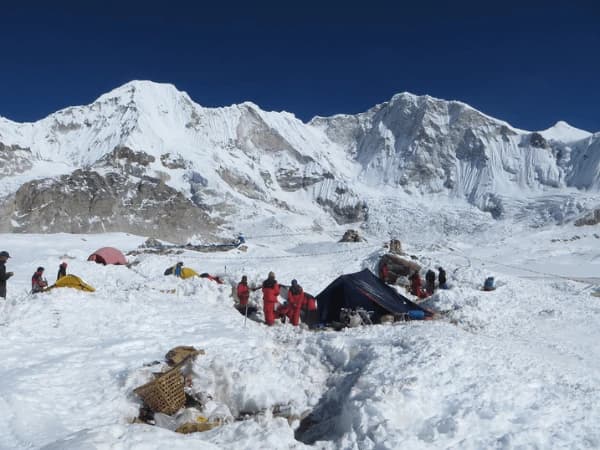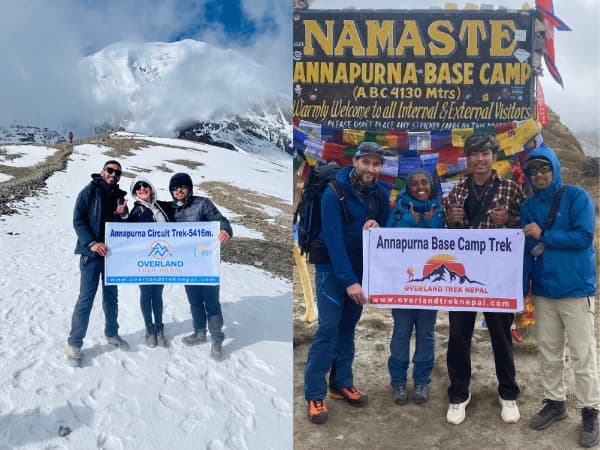Himlung Himal Expedition Cost is a crucial factor for climbers eyeing this 7,126-meter Himalayan peak. Nestled in Nepal’s remote Nar Phu Valley,Himlung Himal offers an ideal first 7000m climb experience – less technical than many peaks, yet truly adventurous. This comprehensive guide breaks down the expenses of a Himlung Himal Nepal expedition, including climbing permit fees, guide and porter charges, accommodation and meal prices, and transportation costs. We also outline a full Himlung Himal expedition itinerary (30 days) to illustrate the journey from Kathmandu to base camp and onward to the summit. By understanding the cost components – from Himlung Himal permits in Nepal to personal gear and insurance – you can budget wisely for this once-in-a-lifetime expedition to Himlung Himal 7126m. Read on to learn why Himlung Himal is a top choice for aspiring high-altitude climbers, how much you should expect to invest, and how Overland Trek Nepal can help turn your Himalayan climbing dream into reality.
Himlung Himal Expedition Cost, Package Price with Guide & Porter
Himlung Himal Expedition Cost Brief Overview
For aspiring mountaineers planning an expedition to Himlung Himal (7,126m), understanding the cost is just as important as training and logistics. The Himlung Himal Expedition cost typically ranges in the thousands of dollars, covering everything from permits and guides to meals on the mountain. In this guide, we’ll explore why Himlung Himal climbing is a great choice for your first 7000m peak, provide a detailed breakdown of the costs involved, present a 30-day Himlung Himal base camp trek and climb itinerary, and answer frequently asked questions about expenses. By the end, you’ll know exactly what goes into the price of a Himlung Himal climbing package and how to prepare for this high-altitude adventure.
Why Choose Himlung Himal for Your First 7000m Climb?
Himlung Himal is often considered an ideal “starter” 7000-meter peak for experienced trekkers looking to step up to an expedition. Located in the remote northwest of Nepal, between the Annapurna and Manaslu ranges, Himlung lies in the restricted Nar Phu Valley – a region previously open only to trekkers. Here are a few reasons why the Himlung Himal Nepal expedition has become popular among climbers aiming for their first 7,000m summit:
- High Success Rate and Moderate Difficulty: Despite its formidable altitude, the Himlung Himal peak climbing difficulty is rated moderate for the Himalayas. The mountain is less technical than peaks like Ama Dablam or most 8000m giants. Climbers face glacier travel, snow and ice slopes, and some fixed-rope climbing, but no extreme technical sections. Himlung boasts one of the highest summit success rates in Nepal
- Expedition Experience without Extreme Hazard: Himlung’s route involves establishing three high camps (around 5,450m, 6,000m, and 6,350m) on generally stable snow slopes. The peak is considered safer in terms of objective hazards like avalanches compared to some other 7000m climbs. You still get a full Himlung Himal climbing expedition experience – with cold high camps and an alpine summit push – but in a relatively less treacherous environment.
- Remote Cultural Trek: The approach to Himlung Himal is an adventure of its own. The Himlung Himal base camp trek takes you through the isolated Nar and Phu villages, where you’ll immerse yourself in Tibetan-derived culture and witness pristine mountain landscapes. Trekking for about a week from Koto to Phu village, you pass narrow gorges, prayer-draped chortens, yak pastures, and ancient monasteries. The trail is far off the beaten path, so climbers enjoy solitude and authenticity that crowded routes like Everest or Annapurna can’t offer. By the time you reach base camp (4,900m) beneath Himlung’s ice slopes, you’ll have experienced a rich journey that few others do.
- Ideal Training for Bigger Peaks: Many climbers choose Himlung as a practice 7000m expedition before tackling 8000m peaks. At 7,126m, it demands high-altitude stamina and expedition logistics (multiple camps, fixed lines, etc.) without the overwhelming scale of Everest or Dhaulagiri. Successfully summiting Himlung Himal proves your ability to handle thin air and cold conditions over a month-long expedition.
- Best Climbing Seasons: The Himlung Himal climbing season aligns with Nepal’s two main climbing periods. Spring (March–May) offers the best weather window with more stable temperatures and typically less snowfall – many teams schedule the summit push in late April or May. Autumn (September–November) post-monsoon is another popular season, with generally clear skies and good conditions in September/October.
In summary, Himlung Himal offers a mix of adventure and attainability. You get the full expedition experience – a month in the mountains, a remote trekking peak-like approach, high camps, and a thrilling summit – without the highest level of technical difficulty. This makes it an outstanding choice for your first 7000m climb, balancing challenge and safety. Now, let’s examine the all-important question: How much does a Himlung Himal expedition cost, and what does that price include?
How Much Does the Himlung Himal Expedition Cost?
The Himlung Himal Expedition cost can vary depending on the expedition package and services, but on average, you should expect a price in the range of USD 7,000 to USD 10,000 per person for a full-service guided climb. Many commercial operators offer Himlung packages for around $9,000, which typically cover all major expenses from Kathmandu to Kathmandu for a small group. Overland Trek Nepal offers a group price starting around $6,000 per person and up to $11,000 for a private or very small team, reflecting the impact of group size and added services.
Several key factors influence the total cost of a Himlung Himal Nepal expedition:
- Group Size: Going with a larger team can significantly reduce the per-person cost. Many fees (transport, logistics, guides) are shared among members, so a team of 6-10 climbers will pay less each than someone climbing solo or with just one partner.
- Level of Service: A bare-bones budget option would include only essentials like permits, basic guide service, and minimal gear, while a full-service package covers extensive support (experienced Sherpa guides, plentiful equipment, better accommodations, oxygen if used, etc.). Himlung expeditions are generally offered as full-service due to the remote logistics, but there is some variation. Higher budgets might afford things like extra oxygen, satellite communication, or a higher guide-to-client ratio.
- Season and Duration: The climbing season can affect the cost. Spring expeditions may be slightly pricier due to higher permit fees and demand, whereas autumn can be a bit less expensive in permit royalties. The length of the trip (some itineraries are 25 days, others 30+ days) also affects cost – every additional day means more spending on accommodations, staff, and food. It’s wise to have a few buffer days for weather, but that will be built into the package price.
- Logistics and Route: Himlung lies in a restricted area, requiring special permits and a longer approach. The need for off-road transport to the trailhead, a trek through a remote region (Nar Phu), and establishing multiple high camps all add to the complexity (and cost) compared to an easier-access peak. Expeditions must hire a liaison officer, equip a full base camp, and possibly use pack animals or porters for heavy loads – all of which are reflected in the price.
Below, we break down the main cost components of a Himlung Himal climbing package so you can see where your money goes.
Climbing Permit Cost for Himlung Himal
One fixed expense for any Himlung Himal expedition is the climbing permit and associated fees paid to the Nepali government. Himlung Himal is a 7,126m peak classified as an expedition peak (not a trekking peak), so its permit must be obtained through the Ministry of Tourism. The permit cost varies by season:
- Climbing Royalty: The Himlung Himal climbing permit (royalty fee) is USD 500 per climber for spring, $250 per climber for autumn, and around $125 per climber for winter/summer. These are the 2025 rates set by Nepal for peaks between 7000m and 7500m. This fee is typically included in your package cost, but it accounts for a significant base cost. Spring is the most expensive because it’s prime climbing season, whereas autumn is half-price and winter is the cheapest due to low demand.
- Restricted Area Permit (Nar Phu Valley): Because the approach to Himlung goes through the restricted Nar Phu Valley (Manang district), a special permit is required for that region in addition to the climbing permit. The Nar Phu Valley permit costs $100 per person per week during Sep-Nov and $75 per week during Dec-Aug, with pro-rated fees for extra days beyond the first week. A Himlung expedition typically spends about 2–3 weeks inside the restricted area, so this can amount to a few hundred dollars per person. Additionally, you’ll need an Annapurna Conservation Area Permit (ACAP), since Nar Phu lies within the ACAP zone – this is about NPR 3,000 ($25) per person.
- Liaison Officer and Garbage Deposit: The Nepalese government requires a Liaison Officer (LO) to accompany expeditions on peaks like Himlung. The LO is an official who helps with communication and ensures regulations are followed. Expedition companies arrange the LO, but the cost is typically around $3,000 (which covers the officer’s salary, transport, and insurance). This cost is usually split among team members and included in your package. There is also a refundable garbage deposit of $500 per team that the government mandates to ensure teams bring back their trash.
- Other Admin Fees: Minor costs like the Trekkers’ Information Management System (TIMS) card (around $20) may apply, although for restricted areas and expeditions, the TIMS is often waived or replaced by the special permit. Also, if your team hires additional support like a high-altitude camera crew or uses drones, there could be extra permit fees. However, for most climbers, these are not applicable.
In summary, permit-related fees for Himlung Himal permits in Nepal can total around $700–$800 in spring (climbing permit + Nar Phu + ACAP) or around $500–$600 in autumn, per person. These fees form the foundation of any Himlung Himal expedition cost – you can’t avoid them, whether you go with an agency or (theoretically) organize independently. The good news is that guided packages invariably include all the necessary permits and the liaison officer arrangements, taking care of the bureaucracy on your behalf.
Meals and Accommodation Costs During the Himlung Expedition
Meals and accommodation during the Himlung Peak climbing are a major part of the cost. Meals and accommodation costs on a Himlung expedition can be broken into three phases: in cities, along the trek, and at base camp (plus above).
- Kathmandu Stay: Your journey will start and end in Kathmandu, where climbers typically spend several nights in a hotel. Many packages include 3–4 nights of hotel accommodation (before and after the climb) in their price. If not included, budget roughly $40–$60 per night for a decent tourist hotel in Kathmandu, or less for budget options. Likewise, you’ll have restaurant meals in the city (perhaps $5–$15 per meal). Often, welcome/farewell dinners are provided by the operator as part of the package.
- Teahouses on the Approach Trek: From the roadhead (Koto village in the Annapurna region) to Phu village, accommodation is available in simple teahouses or lodges. Each day, you or your agency will pay the local lodges for your room and meals. Costs in this remote region are a bit higher than in more developed trekking areas due to the effort of transporting goods. A typical teahouse might charge $35–$40 per person per day for room and full board (meals). This usually includes a basic room (twin-share, simple bed) and dinner, breakfast, plus tea/coffee. Over 6–8 trekking days, that’s on the order of a few hundred dollars per person in food and lodging. In Phu village (4,050m), the last settlement, your team will likely spend a couple of nights acclimatizing – again incurring teahouse costs.
- Base Camp Camping: Once you move above Phu to Himlung Base Camp, there are no lodges – you switch to full camping mode. This is where a large portion of your money goes: supporting a camp kitchen and crew at 4,900m for two or more weeks. A full-service expedition will have a dedicated cook and kitchen helpers at base camp to prepare meals for climbers and staff. All of these logistics are typically included in the package cost – but they’re not cheap. Feeding one person at base camp might cost $30+ per day in just food supplies, not to mention the staff salaries and transport of provisions.
- High Camp Supplies: Above base camp, climbers typically eat freeze-dried or light meals (like instant soups, oatmeal, etc.) that they or the Sherpas prepare with boiling water. Your package may include these high-altitude foods and cooking gas stoves at Camp I/II/III. While the diet is Spartan up high, the cost of supplying it isn’t negligible – but it’s part of the overall service. Some expeditions also bring a dining tent and kitchen up to Camp I for better meals during rotations. Again, more gear and food transported upward means higher costs.
In summary, meals and accommodation from Kathmandu to base camp and back easily account for several hundred to over a thousand dollars of the expedition price. A lot of this is invisible to the climber when you’re served dinner in your tent – but behind the scenes, the operator has paid for that food to be bought in Kathmandu, shipped via bus and mule, carried by porters, and cooked by a staff who also need to be fed and housed.
Climbing Guide Cost for the Himlung Himal Peak Climb
Quality guiding is the backbone of any safe Himalayan climb. The cost for hiring professional guides (usually Sherpa climbers) is another major component of a Himlung Himal climbing package. Here’s what you need to know about guide expenses:
- Guide Salaries: In Nepal, a licensed trekking guide on easier treks might earn around $30–$50 per day, but a specialized climbing guide (especially at high altitude) commands higher wages – often $100–$180 per day or more for expedition peaks. These guides are often Sherpa climbers who have summited 7000m and 8000m peaks; they have technical expertise and risk their lives to help you summit, and their pay reflects that. For a 30-day expedition, one lead climbing Sherpa’s wages can amount to $2,500–$3,000.
- Guide-to-Climber Ratio: Most Himlung expeditions will have at least 1 climbing guide for every 2–3 climbers, and often additional assistant guides. Some operators might provide a 1:1 ratio on summit day for added safety (one personal Sherpa per client), especially if using supplemental oxygen (though Himlung is usually climbed without bottled O2). A higher ratio means better support but also higher cost (since you’re employing more staff). Reputable companies like Overland Trek Nepal prioritize having enough Sherpa support so that each climber gets guidance during the ascent. This is one area where budget operators might cut corners (e.g., one guide for 5 clients, which is less ideal). It’s worth paying for an operator that ensures adequate support.
- Support Staff and Base Camp Guides: In addition to the summit guides, your expedition may include other guiding personnel – for example, a trekking guide who leads the group on the trek into base camp (ensuring no one gets lost en route) and helps with logistics. They might be paid at a slightly lower rate ($30–$40/day) if not involved in technical climbing. There may also be a base camp manager or (lead Sherpa) who oversees operations at camp while climbing Sherpas go up and down. Their compensation is part of the guiding cost, too.
- Insurance and Equipment for Guides: Expedition companies also must cover insurance for their staff (accident, medical, and emergency evacuation insurance). For high-altitude guides, this is expensive – for instance, insurance covering above 6000m can be a few hundred dollars per person. Guides are also provided with mountaineering gear (like ropes, tents, radios) by the operator. All these overheads (insurance, gear, clothing allowance) are factored into what you pay. Essentially, when you see a price tag for Himlung, you’re also funding the safety net for your guides and porters.
In summary, the Himlung Himal climb with a guide is non-negotiable – you are required by regulations to have a guide, and more importantly, it’s vital for your safety. The cost of professional guides is substantial, but this is one area you wouldn’t want to skimp on. Your guides are your lifeline on the mountain – they fix ropes, navigate the route, monitor your health, and make critical decisions. A portion of your expedition cost ensures that you have knowledgeable, well-equipped Sherpa guides by your side. It’s money well spent, and any reputable expedition package will include it. Always verify that your package has an adequate number of certified climbing guides and support staff for the team size.
Cost of Porter Support for Himlung Himal
To move loads of equipment and supplies through the Himalayas, human (and animal) strength is indispensable. Porters and sometimes pack animals are employed on Himlung expeditions to carry gear to base camp and even between high camps. Here’s how porter costs contribute to the expedition budget:
- Trek to Base Camp – Porter Needs: From Koto (the road end) to Himlung Base Camp is many days of trekking, and climbers alone cannot carry all the tents, food, fuel, rope, and group equipment needed. Porters are hired to ferry loads to base camp. A typical porter in Nepal carries about 20–30 kg, often transporting two clients’ duffel bags or a load of communal gear. Porter wages on such remote treks range from $25–$30 per day. If it takes, say, 7 days to reach base camp and 5 days to trek back out (as in the itinerary), and one porter is shared by two climbers, you’re looking at roughly 12 days × $30 = $360 in porter wages.
- High-Altitude Porters: Himlung Himal requires establishing multiple high camps. In some cases, expedition teams use high-altitude porters or additional Sherpa support to carry heavy loads (ropes, tents, oxygen if used, etc.) up to Camp I, II, and III. These individuals are essentially guides performing load carries. Their compensation is higher than a normal porter’s due to the danger and difficulty, often equal to Sherpa guide pay for high-altitude days. Not every expedition will have separate “porters” above base camp (often the climbing Sherpas double as load carriers during the rotation). But if yours does, it’s another cost factor. For example, ferrying loads to 6000m might incur bonus pay or extra staff hiring. This is generally wrapped into the overall guide/staff cost of the package.
- Pack Animals: On the trek to Phu, there might be the possibility to use mules or yaks to carry equipment part of the way (some trails allow mule caravans). Using pack animals can sometimes reduce the number of human porters needed. Their cost might be charged per animal or per kilo. In Nar Phu, mules can sometimes be hired up to certain villages. Regardless, the cost difference isn’t huge – whether on the backs of yaks or porters, the supplies still require payment, and the agency will choose the most feasible method.
Transportation Cost
Getting to and from the remote starting point of the trek is another expense to factor in. Himlung Himal is accessed via the Annapurna Circuit trail for the first leg, which means there is no direct airstrip—travel is overland. Key transport costs include:
- Kathmandu to Koto (Trailhead): Most Himlung itineraries begin with an overland journey from Kathmandu to Besisahar (about 7-8 hours by road) and onwards to Koto. Typically, a private jeep or minibus is arranged for the team. The cost of a private 4x4 vehicle for these long drives can be on the order of a few hundred dollars each way. For example, hiring a jeep from Kathmandu to Besisahar might cost $200–$250, and another jeep from Besisahar up the rough road to Koto could be a similar amount. If you have 4-5 members, that cost is split (e.g., $50+ per person). If you’re alone, you’d bear the full cost unless you use public transit. Public buses are a budget alternative (maybe $10–$15 to Besisahar), but they are slower and less comfortable, and beyond Besisahar, public transport is limited – you might catch a local jeep to Koto if available. In a guided package, transportation is generally included, meaning the agency covers the private jeep fees. It’s worth about $300–$500 total round-trip for the vehicle, which you ultimately pay for within your package.
- Return Journey: After finishing the expedition, the same route is taken back: Koto to Besisahar (jeep) and Besisahar to Kathmandu (drive). Again, the cost for vehicles/fuel/driver needs to be paid. Expeditions will usually have this pre-arranged, so you aren’t stranded waiting for a ride. If roads are blocked or unsafe (occasionally, landslides can occur), sometimes a helicopter evacuation from the trail might be considered as a very expensive contingency (not common unless there’s an emergency).
- Local Transportation: Minor transport costs include airport pickups, hotel transfers in Kathmandu, etc. These are small ($5-$20 each) and often bundled into the service. Overland Trek Nepal, for instance, provides airport transfers and all necessary ground transport in their packages (so you wouldn’t be paying for taxis out of pocket).
In essence, transportation costs for Himlung are straightforward and usually fixed regardless of group size (a jeep costs the same whether 2 or 5 people are in it). So, larger groups have an advantage here by sharing the vehicle expense. If you plan to arrange your transport to save money, going by local bus to Besisahar and then hoping to find a shared jeep to Koto can indeed lower costs, but adds uncertainty and time. Most climbers opt to let the agency handle logistics, which ensures a timely and secure trip to the trailhead. In the big picture, transport is a smaller fraction of the total expedition cost compared to permits or staff – but it’s essential; you have to get yourself and a ton of gear to that mountain! Rest assured that any full package will cover these travel costs, and it will be listed in the inclusions.
Extra Expenses during Himlun Himal Expedition: Personal Trekking Gear & Travel Insurance
Beyond the core package price, every climber should budget for personal items and contingencies that are typically not included in the Himlung Himal Expedition cost. These extra expenses can significantly add up, so plan for them in advance:
- Personal Climbing Gear: Himlung Himal, being a 7000m peak, requires extensive mountaineering gear. While group equipment (tents, ropes, cooking gear) is provided by the Overland Trek Nepal, you must have your climbing kit. This includes high-altitude double boots, crampons, ice axe, climbing harness, ascender (jumar), carabiners, helmet, down suit or heavy down jacket and pants, base layers, mittens and gloves, sunglasses/goggles, sleeping bag (rated to -30°C or colder), etc. If you already own these from past climbs, great – you won’t have to spend much beyond maybe replacing worn items. If not, you have two options: buy or rent in Kathmandu. Buying top-of-the-line gear can run into thousands of dollars (e.g., new double boots $800, down suit $1000).
- Travel Insurance (with Evacuation Coverage): Insurance is mandatory for high-altitude expeditions. You need a policy that covers trekking/climbing up to 7000m and includes emergency helicopter evacuation and medical treatment. Standard travel insurance often doesn’t cover mountaineering above certain altitudes, so you may need a specialized policy or add-on. The cost of such insurance for a 30-day expedition can range from around $150 to $300, depending on your age, home country, and coverage limits. For example, insurers like Global Rescue, World Nomads, or Alpine Ascents offer high-altitude plans – a rough estimate is $5-$10 per day of coverage per person for climbing expeditions. Do not skimp on insurance: a helicopter evacuation in the Nepal Himalaya can cost $5,000 – $10,000 upfront, which you must pay if uninsured. Also, high-altitude medical issues (HAPE, HACE, frostbite) could require expensive hospital care. Ensure your policy covers climbing (some categorize Himlung as “trekking peak,” which might be okay, but clarify the altitude limit and technical climbing coverage). This insurance cost is separate from your expedition fee and is rarely included by the operator. Obtain your insurance at home before traveling, and bring the documentation. It’s a small price to pay for peace of mind.
- Visa and Travel: Don’t forget the Nepal entry visa fee. A 30-day tourist visa costs about $50 (on arrival at the airport). If you plan to stay longer, a 90-day visa is $125. This is an upfront travel expense. Also, budget for your international flight to Nepal (varies by origin) – not part of the expedition cost, but a necessary expense.
- Personal Expenses and Tips: While on the expedition, you might incur miscellaneous costs: snacks beyond what’s provided (chocolate bars or cola in teahouses), hot showers or battery charging fees in lodges, buying a local SIM card or WiFi access, etc. These are usually small ($1-$5 at a time) but can total $50-$100 over a month. More significantly, tipping your crew at the end is expected in Nepal. Plan to tip your guides, Sherpas, cooks, and porters as a thank you for their hard work. How much to tip is subjective, but a common pool tip amount might be 10% or more of your expedition cost divided among the staff.
- Contingency Funds: It’s wise to have some extra cash (or credit limit) available for unforeseen expenses. This could be used for extra nights in Kathmandu if your trip extends (e.g., delayed by weather), medical expenses not covered on the mountain, or gear replacement if something fails. A few hundred dollars held in reserve is a good idea.
Himlung Himal Expedition Itinerary
To put the costs in context and help you envision the journey, below is a 30-day outline itinerary for a Himlung Himal Expedition. This schedule is designed for proper acclimatization and includes a culturally rich approach through the Nar Phu Valley, a flexible climbing period, and ample buffer days.
- Day 1: Arrival in Kathmandu (1,400m) – Meet your expedition team and transfer to the hotel. Trip briefing in the evening.
- Day 2: Kathmandu preparation day – Final gear checks, meet guides, secure climbing permits. (Optional sightseeing in Kathmandu Valley.)
- Day 3: Drive from Kathmandu to Besisahar (760m) – 7-hour drive by private vehicle along scenic highways to this trailhead town.
- Day 4: Drive from Besisahar to Koto (2,675m) – A rough 4x4 jeep road (5–6 hours) through villages and along the Marsyangdi River. Check in at Koto, the gateway to Nar Phu.
- Day 5: Trek from Koto to Meta (3,560m) – 6–7 hours trekking. Enter the Nar Phu Valley, following forested trails by the Nar Khola. Overnight in a basic teahouse at Meta village.
- Day 6: Trek from Meta to Kyang (3,740m) – 6–7 hours. The trail passes through interesting Tibetan-influenced settlements (Chyaku, Jhunam) and scenic canyons. Camp or stay at Kyang, a seasonal herding camp area.
- Day 7: Trek from Kyang to Phu Village (4,050m) – 5–6 hours. A dramatic path along cliffs and gorges leads to the medieval stone-walled village of Phu. Magnificent views of Himlung Himal and the surrounding peaks.
- Day 8: Acclimatization day at Phu – Rest and explore Phu Village. Hike to viewpoints or monasteries (e.g., Tashi Lhakhang Monastery) to gain altitude and help your body adjust.
- Day 9: Trek from Phu to Himlung Himal Base Camp (4,900m) – 4–5 hours. Follow a rugged trail above Phu through glacial moraines to reach Base Camp on a rocky meadow. Set up camp.
- Day 10: Rest and acclimatization at Base Camp – Prepare climbing gear, practice fixed rope techniques, and allow your body to adapt to 5,000m. Enjoy incredible panoramas of Himlung and the barren Nar Phu landscapes.
- Days 11–22: Climbing Period (Himlung Himal Summit 7,126m) – 12 days reserved for climbing. Establish Camp I (5,450m), Camp II (6,000m), and a high Camp III (6,350m) on the route. Sherpa guides will fix ropes on steeper sections as needed. Multiple rotation climbs are done: you’ll climb up to higher camps and come back to Base Camp to rest, to acclimatize. When weather permits and everyone is properly acclimatized, the team launches a summit attempt (usually from Camp III). Summit day involves an alpine start (pre-dawn) and climbing moderate snow and ice slopes to the top of Himlung Himal (7,126m). From the summit, enjoy breathtaking views of Annapurna II, Gangapurna, Manaslu, and the Tibetan plateau. After the summit, descend carefully to Base Camp over 1-2 days. (Note: The exact schedule for these days is flexible. The team may not use all 12 days if the weather is good early, or may extend if needed.)
- Day 23: Extra day at Base Camp – Contingency for weather delays or additional rest after the climb. Begin packing up camps and celebrate the success with your crew.
- Day 24: Trek from Base Camp back to Phu (4,050m) – 3–4 hours downhill. Say goodbye to the high peaks as you return to the relative comfort of Phu village.
- Day 25: Trek from Phu to Meta – 5–6 hours retracing steps through the Nar Phu gorge. You’ll feel the air thicken as you lose elevation. Night in Meta.
- Day 26: Trek from Meta to Koto – 5–6 hours. Exit the restricted area and rejoin the Annapurna Circuit trail at Koto. Last night on the trail, enjoy a nice meal with the team.
- Day 27: Drive from Koto to Besisahar – Take a jeep down the bumpy road along the Marsyangdi River. In Besisahar, you’ve re-entered civilization (hot showers and cold drinks!).
- Day 28: Drive from Besisahar to Kathmandu – 6–7-hour drive back to the capital. Transfer to your hotel and enjoy a celebratory farewell dinner in Kathmandu.
- Day 29: Leisure day in Kathmandu – Buffer Day in case of delays. You can relax, go souvenir shopping, or tour more cultural sites. (This day is also useful to rest before a long flight home.)
- Day 30: Departure from Nepal – Transfer to Tribhuvan International Airport for your flight home, with unforgettable memories of Himlung Himal.
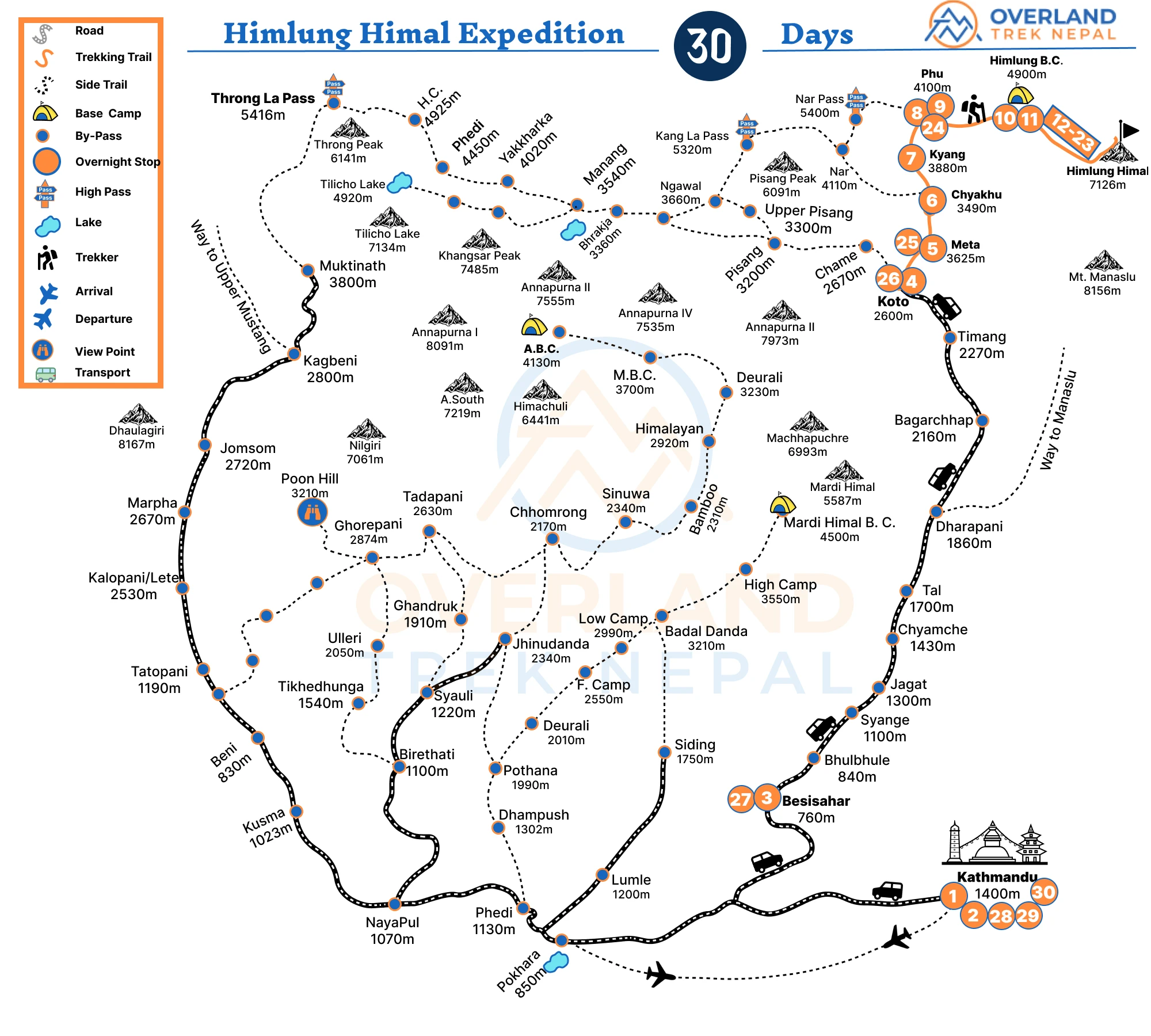
This Himlung Himal expedition itinerary provides a balanced mix of adventure and acclimatization. It’s important to note that flexibility is key in the mountains – weather, trail conditions, or team health can necessitate changes on the fly. Overland Trek Nepal has designed itineraries with spare days and adjusts the schedule as needed to maximize safety and summit success.
FAQs
How much does it cost to climb Himlung Himal?
A: The cost to climb Himlung Himal typically ranges from about USD 9000 up to 15,000+ per person for a fully guided expedition. The exact price depends on factors like group size, the services included, and the operator you choose. For instance, a standard package with Overland Trek Nepal in 2025 might be around $9,000 per person for a small group, which includes permits, guide/porter services, meals, transportation, and group equipment. The Himlung Himal expedition cost reflects the logistics of a remote 30-day climb, so expect it to be a significant investment, though still less than expeditions to 8000m peaks.
What is included in the Himlung Himal expedition package cost?
Our Himlung Himal package will typically include: climbing permit fees and Nar Phu restricted area permits, all transportation within Nepal (private jeeps/bus to the trailhead and back, airport transfers), accommodations, all meals during the trek and climb, services of an experienced climbing guide (Sherpa), and necessary porters.
Can I climb Himlung Himal without a guide? How much does a climbing guide cost for the Himlung Expedition?
In practice, no-climbing Himlung independently is not feasible nor allowed under current rules. Himlung lies in a restricted area (Nar Phu Valley), which by law requires at least two trekkers accompanied by a registered guide to obtain the permit. Solo permits are not issued for that region. Moreover, as of 2023, Nepal has effectively banned solo trekking and climbing without a guide for safety reasons.
When is the best time to climb Himlung Himal, and does it affect the cost?
The best times to climb Himlung Himal are spring (April-May) and autumn (September-October). These seasons offer the most stable weather for high-altitude climbing – reasonable temperatures, lower precipitation, and more predictable conditions. Spring tends to have a bit more snow accumulation from winter (which can aid in covering crevasses), and many teams aim for a May summit. Autumn offers post-monsoon clear skies, especially in September and October, making for excellent climbing days.
Cost-wise, the season can have a slight impact primarily through permit fees: spring climbing permits for Himlung are the most expensive (about $500), while autumn permits are half that ($250). This means an autumn expedition might be a few hundred dollars cheaper per person in terms of fees.
Conclusion
Conquering Himlung Himal is not just about reaching a summit – it’s about undertaking a journey that tests your limits, immerses you in raw Himalayan beauty, and ultimately rewards you with memories for a lifetime. While the Himlung Himal Expedition cost may seem significant, it encompasses an entire month of experiences: trekking through hidden valleys, living among Nepali and Tibetan cultures, and climbing in the footsteps of pioneering mountaineers.
At Overland Trek Nepal, we believe that this grand 7,126m adventure should be as rewarding and hassle-free as possible for you. As a Nepal-based expedition specialist, our focus is on providing top value and expert guidance. We handle all the logistics – obtaining permits, setting up comfy base camp facilities, employing seasoned climbing Sherpa guides, and ensuring every meal and every rope is taken care of – so you can fully immerse yourself in the climb. Our transparent pricing means no hidden costs; instead, you get a fair package that covers all the essentials needed for a safe and successful ascent. Contact us via Emailor WhatsApp us at +9779841920870.
